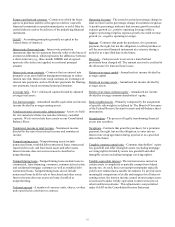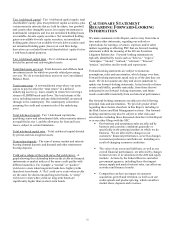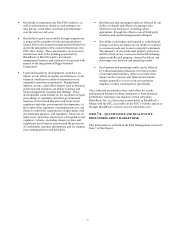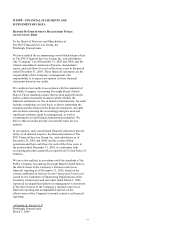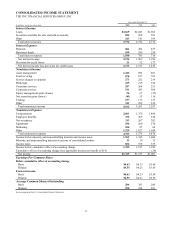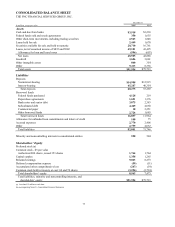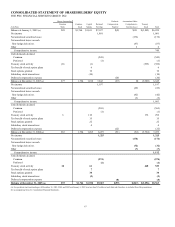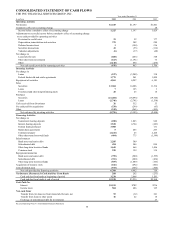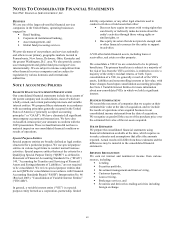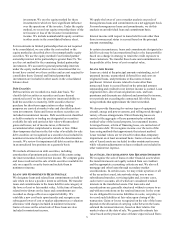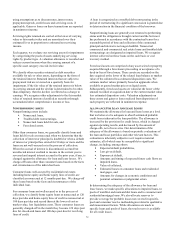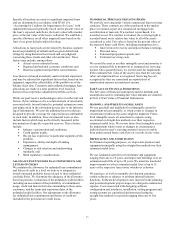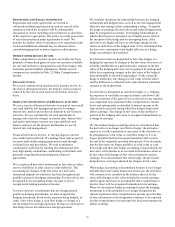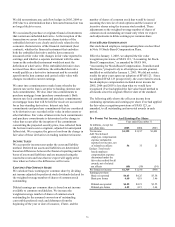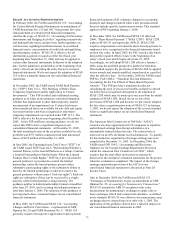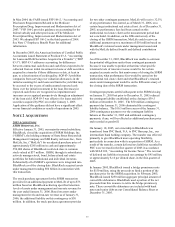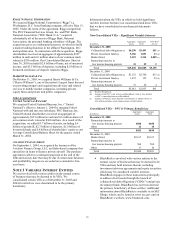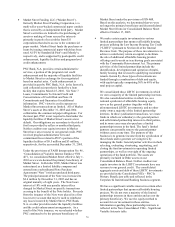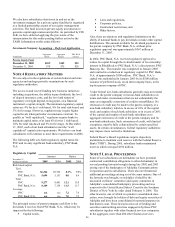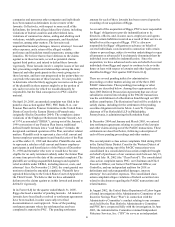PNC Bank 2005 Annual Report Download - page 71
Download and view the complete annual report
Please find page 71 of the 2005 PNC Bank annual report below. You can navigate through the pages in the report by either clicking on the pages listed below, or by using the keyword search tool below to find specific information within the annual report.71
investment. We use the equity method for those
investments in which we have significant influence
over the operations of the investee. Under the equity
method, we record our equity ownership share of the
net income or loss of the investee in noninterest
income. We include nonmarketable equity securities
in other assets in the consolidated balance sheet.
For investments in limited partnerships that are not required
to be consolidated, we use either the cost method or the
equity method as described above for nonmarketable equity
securities. We use the equity method if our limited partner
ownership interest in the partnership is greater than 3%. We
use the cost method for the remaining limited partnership
investments. We account for general partnership interests
under the equity method when we have determined that we
do not have control over these entities and are not required to
consolidate them. General and limited partnership
investments are included in other assets in the consolidated
balance sheet.
Debt Securities
Debt securities are recorded on a trade-date basis. We
classify debt securities as securities and carry them at
amortized cost if we have the positive intent and ability to
hold the securities to maturity. Debt securities that we
purchase for short-term appreciation or other trading
purposes are carried at market value and classified as short-
term investments. Gains and losses on these securities are
included in noninterest income. Debt securities not classified
as held to maturity or trading are designated as securities
available for sale and carried at fair value with unrealized
gains and losses, net of income taxes, reflected in
accumulated other comprehensive income or loss. Other-
than-temporary declines in the fair value of available for sale
debt securities are recognized as a securities loss included in
noninterest income in the period in which the determination
is made. We review for impairment all debt securities that are
in an unrealized loss position on a quarterly basis.
We include all interest on debt securities, including
amortization of premiums and accretion of dis counts using
the interest method, in net interest income. We compute gains
and losses realized on the sale of debt securities available for
sale on a specific security basis and include them in
noninterest income.
LOANS AND COMMITMENTS HELD FOR SALE
We designate loans and related loan commitments as held for
sale when we have a positive intent to sell them. We transfer
loans and commitments to the loans held for sale category at
the lower of cost or fair market value. At the time of transfer,
related write-downs on the loans and commitments are
recorded as charge-offs or as a separate liability. We
establish a new cost basis upon transfer and recognize any
subsequent lower of cost or market adjustment as a valuation
allowance with charges included in noninterest income.
Gains or losses on the actual sale of these loans are also
included in noninterest income.
We apply the lower of cost or market analysis on pools of
homogeneous loans and commitments on a net aggregate basis.
For non-homogeneous loans and commitments, we do this
analysis on an individual loan and commitment basis.
Interest income with respect to loans held for sale other than
those in nonaccrual status is accrued based on the principal
amount outstanding.
In certain circumstances, loans and commitments designated as
held for sale may be later transferred back to the loan portfolio
based on a change in strategy to retain the credit exposure to
those customers. We transfer these loans and commitments to
the portfolio at the lower of cost or market value.
LOANS AND LEASES
Loans are stated at the principal amounts outstanding, net of
unearned income, unamortized deferred fees and costs on
originated loans, and premiums or discounts on loans
purchased. Interest income related to loans other than
nonaccrual loans is accrued based on the principal amount
outstanding and credited to net interest income as earned. Loan
origination fees, direct loan origination costs, and loan
premiums and discounts are deferred and amortized to income,
over periods not exceeding the contractual life of the loan,
using methods that approximate the interest method.
We also provide financing for various types of equipment,
aircraft, energy and power systems, and rolling stock through a
variety of lease arrangements. Direct financing leases are
carried at the aggregate of lease payments plus estimated
residual value of the leased property, less unearned income.
Leveraged leases, a form of financing lease, are carried net of
nonrecourse debt. We recognize income over the term of the
lease using methods that approximate the interest method.
Lease residual values are reviewed for other-than-temporary
impairment on at least an annual basis. Gains or losses on the
sale of leased assets are included in other noninterest income
while valuation adjustments on lease residuals are included in
other noninterest expense.
LOAN SALES , SECURITIZATIONS AND RETAINED INTERESTS
We recognize the sale of loans or other financial assets when
the transferred assets are legally isolated from our creditors
and the appropriate accounting criteria are met. We also sell
mortgage and other loans through secondary market
securitizations. In certain cases, we may retain a portion or all
of the securities issued, interest-only strips, one or more
subordinated tranches, servicing rights and, in some cases,
cash reserve accounts, all of which are considered retained
interests in the transferred assets. Our loan sales and
securitizations are generally structured without recourse to us
and with no restrictions on the retained interests. In the event
we are obligated for recourse liabilities in a sale, our policy is
to record such liabilities at fair value upon closing of the
transaction. Gains or losses recognized on the sale of the loans
depend on the allocation of carrying value between the loans
sold and the retained interests, based on their relative fair
market values at the date of sale. We generally estimate fair
value based on the present value of future expected cash flows


